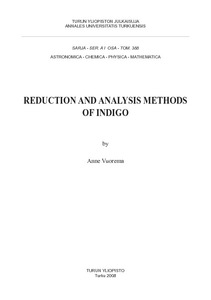Reduction and Analysis Methods of Indigo
Vuorema, Anne (2008-12-19)
Reduction and Analysis Methods of Indigo
Vuorema, Anne
(19.12.2008)
Turun yliopisto Annales Universitatis Turkuensis A I 388
Julkaisun pysyvä osoite on:
https://urn.fi/URN:ISBN:978-951-29-3782-0
https://urn.fi/URN:ISBN:978-951-29-3782-0
Kuvaus
Siirretty Doriasta
ei tietoa saavutettavuudesta
ei tietoa saavutettavuudesta
Tiivistelmä
Throughout history indigo was derived from various plants for example Dyer’s Woad (Isatis tinctoria L.) in Europe. In the 19th century were the synthetic dyes developed and nowadays indigo is mainly synthesized from by-products of fossil fuels. Indigo is a so-called vat dye, which means that it needs to be reduced to its water soluble leucoform before dyeing. Nowadays, most of the industrial reduction is performed chemically by sodium dithionite. However, this is considered environmentally unfavourable because of waste waters contaminating degradation products. Therefore there has been interest to find new possibilities to reduce indigo. Possible alternatives for the application of dithionite as the reducing agent are biologically induced reduction and electrochemical reduction. Glucose and other reducing sugars have recently been suggested as possible environmentally friendly alternatives as reducing agents for sulphur dyes and there have also been interest in using glucose to reduce indigo. In spite of the development of several types of processes, very little is known about the mechanism and kinetics associated with the reduction of indigo. This study aims at investigating the reduction and electrochemical analysis methods of indigo and give insight on the reduction mechanism of indigo. Anthraquinone as well as it’s derivative 1,8-dihydroxyanthraquinone were discovered to act as catalysts for the glucose induced reduction of indigo. Anthraquinone introduces a strong catalytic effect which is explained by invoking a molecular “wedge effect” during co-intercalation of Na+ and anthraquinone into the layered indigo crystal.
The study includes also research on the extraction of plant-derived indigo from woad and the examination of the effect of this method to the yield and purity of indigo. The purity has been conventionally studied spectrophotometrically and a new hydrodynamic electrode system is introduced in this study. A vibrating probe is used in following electrochemically the leuco-indigo formation with glucose as a reducing agent.
The study includes also research on the extraction of plant-derived indigo from woad and the examination of the effect of this method to the yield and purity of indigo. The purity has been conventionally studied spectrophotometrically and a new hydrodynamic electrode system is introduced in this study. A vibrating probe is used in following electrochemically the leuco-indigo formation with glucose as a reducing agent.
Kokoelmat
- Väitöskirjat [3065]
